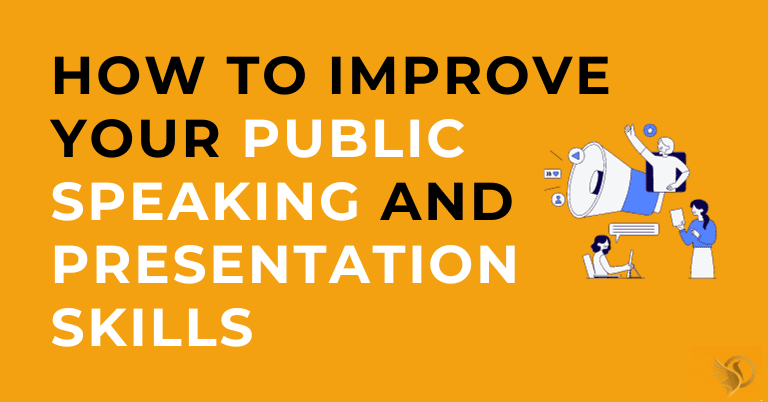Public speaking needs to be one of the most significant professional abilities because it is employed in almost every business. However, it is also one that many people fear. The good news is that speaking comfortably and effectively in front of a group is a talent everyone can learn.
You must speak in front of a group sometime in your career. It is critical to have great presentation skills and communication skills while presenting a new project to your team members or pitching an idea to a client.
With a little practice, you can enhance your public speaking skills by presenting findings to your team or explaining complex concepts to potential investors. Here are ten ways you can begin practicing right away.
We will share tips to improve your public speaking and presentation skills. Let’s move to understanding public speaking skills.
Importance of Excellent Public Speaking Ability
Strong public speaking skills can help you soar high in your career and make you different from the rest of your peers. It is one of the skills that a great leader possesses.
Public speaking is one of the most effective ways to convey your message, demonstrate your knowledge, and influence others. It can also help you stay organized and improve your writing and communication skills.
Many people who appear at comfortable in front of large gatherings were formerly scared of public speaking. You can significantly improve your life by conquering this fear, practicing, and gaining confidence.
10 Strategies for Better Public Speaking
We’ll give you ten suggestions for boosting your public speaking skills.
1. Understand your target audience
You’ll feel more at ease presenting to an audience if you know who they are. That way, you can frame your message in a tone they will understand, employing humor to relieve stress.
Begin by analyzing your audience’s comprehension of the topic you intend to present. This will influence how much background you include and whether you should be more professional or casual.
Keep an eye on the group’s reactions while you talk. Adjust as needed to maintain eye contact with them during the presentation.
2. Practice, practice, and practice some more
Even the most experienced public speaker requires practice to be effective. Make a practice presentation of your speech beforehand to see if you’ve organized the information cohesively.
It may be beneficial to practice in front of a mirror or in front of an imaginary audience. Still, it is even more useful to practice with a supportive coworker, friend, or family member as an audience.
3. Take advantage of feedback
Ask for comments, whether you’re practicing or presenting a presentation. This constructive critique may give specific examples of how you might enhance future presentations.
If your friends point out that you use “umm” or “you know” too much, don’t take it personally. Incorporate their suggestions into future presentations, and thank your friend or team for their important feedback.
4. Personalize it
When you add your own personality or flair, it can be easier to connect with an audience. Allow your personality to shine through when you communicate your message, whether naturally witty or empathic. Be genuine and appropriate—use humor when it may improve rather than distract from your work.
If you use a PowerPoint presentation while speaking, ensure you’re not reading from it word for word but rather employing graphics or videos to bring your presentation to life. You should include your contact information at the end of the presentation so people can contact you afterward.
5. Relate to a personal story
Personal anecdotes or stories enrich your presentation. When TED Talk speakers reach the stage, they frequently begin with a brief narrative from their childhood or a personal experience. This format allows them to interact with the audience, express their enthusiasm for the topic, and demonstrate their knowledge.
To give a personal touch to your presentation, make sure everything you discuss is directly related to the issue at hand.
6. Make direct eye contact
Making eye contact with your audience makes you feel more at ease since you’ll get a sense of whether or not they understand what you’re saying. Making eye contact can be more comfortable if you practice your speech or presentation beforehand.
Body language, as they say, is crucial to efficient communication. Moving your glance across the room might make your audience feel more involved, making you feel more secure.
7. Take advantage of the stage
Know where you’ll be presenting before the presentation. Make sure you understand how the room will be configured. Inquire about time limits, if people will be eating during your presentation and the type of microphone you will use.
Own the stage when you’re on it. Move throughout the room, making eye contact with those in the audience. Be mindful of your body language. Allow your arms to hang freely. Have a good body posture and keep smiling.
8. Relax your muscles.
Despite your preparation, it is common to feel nervous at some point during your presentation. Take a big breath when this happens. Nobody expects you to be flawless.
Instead of stuffing your hands in your pockets or fiddling with your hair, plan ahead of time how you will deal with your nerves. Try exercising or meditating for five minutes before speaking.
9. Take a recording of yourself speaking.
Coworkers and friends can provide feedback, but you can also analyze yourself while speaking. Set up your phone to record yourself and watch it later when you speak in front of a group. Your uneasy tendencies or clumsy phrasing may surprise you. You might discover new techniques to make your PowerPoint slides more readable.
Consider you’re giving a presentation on Zoom, ask if you can record the session. Use this technology to better your talents and avoid brooding on blunders in the future. Maintain an optimistic attitude.
10. Make a compelling finish to leave a lasting impression.
Experts advise speakers to capture their audience’s attention in the first 30 seconds of their presentations, and it’s also a good idea to have a powerful finale to any presentation. This conclusion may include the following:
- A call to action that inspires listeners to take action
- A remarkable quote from your presentation that motivates or highlights a
- A personal tale about why this subject is so important to you
- A summary of the most essential lessons learned
When you finish your presentation, remember to thank the audience for their time. Also, ask the audience to ask questions and answer them from the stage, or you can ask them to follow up with you later.
What exactly are presenting skills?
Presentation skills are a collection of abilities to communicate information to an audience effectively. These abilities include everything from research and organization to delivery and post-delivery analysis. Depending on the nature of your work, you may present reports to colleagues or supervisors, train new workers, or provide project updates to clients. An excellent presentation is interesting, relevant, clear, and brief. Employers often favor recruiting applicants with strong presenting abilities, especially if they will be working with clients. These skills are critical in gaining the trust of clients and customers.
Mastering important presentation skills
A good presentation starts with careful planning and preparation. It thus necessitates the use of a set of abilities in order to offer reliable information. Consider working on the following domains to build critical presentation skills:
1. Research
Research is a systematic process that includes gathering data, documenting key information, analyzing it, and interpreting it using methods recognized by a relevant academic subject. It employs inductive and deductive reasoning processes to generate meaningful information. Inductive reasoning is used to create new theories, whereas deductive reasoning is used to test current hypotheses.
- Data interpretation
- Brainstorming
- Inductive and logical thinking
- Computer and Internet literacy
After gathering information and analyzing it to produce inferences, the next stage is to organize things to form a logical narrative. This includes linking thoughts and concepts to data and instances. This step would concentrate on creating aids or guidelines to help you communicate the message. You can then build a more specific plan for yourself, defining the content that you may deliver.
- Logic planning
- Prioritization
- Grammar and spelling
- Proofreading and editing
2. Delivery
The term “delivery” relates to your performance during a presentation. It is an essential component of all presentations and is as significant as your content. Good oratory skills, as well as verbal and nonverbal communication abilities, are often required for delivery. To motivate an audience to pay attention to the information you provide, project confidence through your tone and body language. When you speak, keep your back upright and your shoulders from drooping. Try not to rush through your presentation, and instead, pay attention to your surroundings and the reactions of your audience. To improve comprehension, pronounce words.
- Clarity and enunciation
- Listening actively
- Body language awareness
- Audience participation
- Memorization
3. Analysis
If you’ve ever delivered a presentation when the audience was visibly bored, it’s possible that you ignored the value of audience analysis. It is always beneficial to consider who you are speaking with and why they are listening to you. Audience analysis is the process of gathering information about your audience in order to establish a broad view, which is then used to construct your presentation. This entails accommodating their level of comprehension, technical literacy, core values, preferences, and hobbies.
- Optimization of observation
- Judgment and evaluation
- Improvisation
Do you want to Improve your Public Speaking Skills and Communication Skills?
Online public speaking courses allow you to learn how to improve your communication abilities from the comfort of your own home or office. Take the Image Coach Shivani introduces the Public Speaking course and Communication Skills course that can help you to acquire confidence while learning presentation and public speaking abilities.


